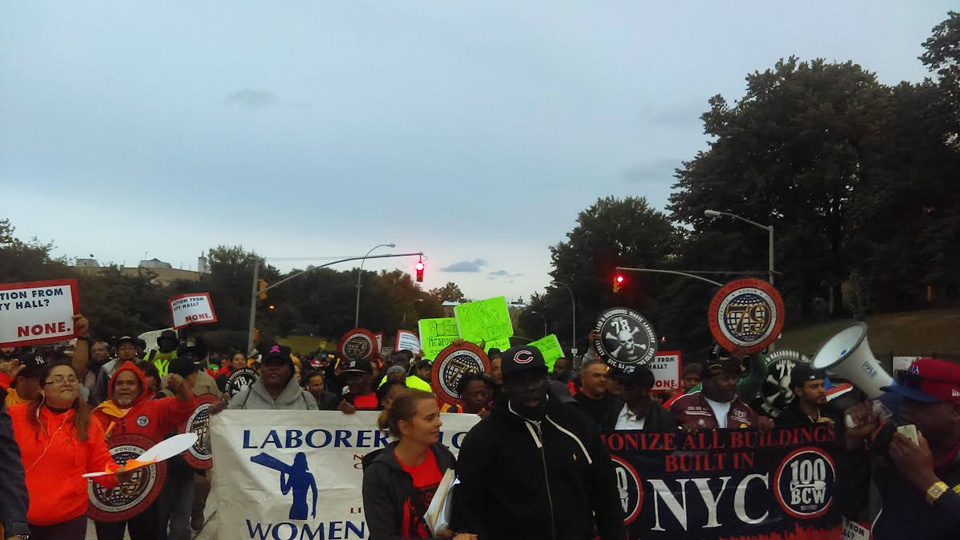
Bronx residents mobilized last Thursday under the banner of the Bronx Coalition for A Community Vision to resist a development plan that threatens to displace an entire neighborhood. Several hundred community members rallied on the corner of West Burnside and University Ave.
They then marched to Bronx Community College where a public hearing was held regarding a draft of the project the Department of City Planning (DCP) put forward in late August. The draft scope describes the development plans DCP and private developers have for Jerome Avenue and its impact on the surrounding neighborhoods – Community Boards 4 and 5.
Chants of “Whose Bronx? Our Bronx!” filled the street as local residents made their way to the hearing. They represented organizations like Community Action for Safe Apartments – New Settlement Apartments (CASA); the Northwest Bronx Community and Clergy Coalition; 100 Black Construction Workers; Construction & General Building Laborers Local 79; Local 79 Women’s Committee; Asbestos, Lead, & Hazardous Waste Laborers Local 78; and Picture the Homeless. Northern Manhattan is Not for Sale/Alto Manhattan No Se Vende (NMN4$) was also present in solidarity with their northern neighbors across the river.
Upon reaching the college, campus police attempted to discourage local residents from entering the public meeting hall with a bottlenecking checkpoint and by claiming the room was already filled to capacity. Nonetheless, patience and determination won the day until the representatives of the DCP were at last met with a strong community united in their knowledge of what they wanted and needed.
The rezoning plan for Jerome Avenue is one piece of a city-wide initiative by the de Blasio administration to boost private housing development in 15 neighborhoods . In exchange for subsidies that afford developers tax exemptions for decades at a time, the new buildings must include what is described as affordable housing.
Various options exist for how Mandatory Inclusionary Housing (MIH) is put into place, but for low income areas like those covered by Community Boards 4 and 5, where the median income is $25,900 per year, even the best option only ensures that 20 percent of new units are made affordable to those making $31,080 per year. The plan fails to meet the needs of 78 percent of the local population.
Nearly every neighborhood slated to be targeted for rezoning is overwhelmingly a community of color. While MIH allows for luxury apartment buildings to be placed in working-class communities, the majority of the new units are totally out of range for the people who already live there. Yet, when new private housing projects have been proposed in more affluent areas like Chelsea, developers have evaded application of MIH rules completely, refusing to make wealthy neighborhoods accessible to working people.
The Mayor’s housing plan was released in May of 2014. Four months later, residents of the Southwest Bronx learned about plans to rezone the 73-block stretch from 167th to 183rd street that DCP has described as “the central spine of several neighborhoods including Highbridge, Concourse, Mt. Eden, Mt. Hope, University Heights, and Fordham.” Soon after, a series of back-door meetings were held between the DCP and unidentified stakeholders by invitation only.
Bronxites began to take matters into their own hands to prevent this speculative root from taking hold. A meeting was held to talk to the broader community about what was going on and a steering committee of tenants, union members, auto workers, activists, and faith leaders was formed. Over 500 surveys were collected and four “visioning sessions” were held with the community to identify problems, brainstorm solutions, and to develop and prioritize demands. A final community vision was agreed upon incorporating concerns related to jobs, affordable housing, community involvement, and tenant harassment. It was released to over 700 residents, workers, and city officials on Oct. 21, 2015.
A letter was sent to Carol J. Samol, Bronx Borough Director of the NYC Department of City Planning, to outline their recommendations for the Jerome Ave plan. The DPC delayed it’s release of the draft scope in response, but what was finally released in late August does not meet many of the concerns of the community, neighborhood leaders involved in the process say.
The coalition issued a press release expressing their deep disappointment. “We believe this plan is about relocation, gentrification and displacement. We say no to the plan and yes to the Bronx,” they concluded.
Following Thursday’s march, over 170 residents signed up to speak at the public hearing to articulate their frustration and anger. At 11p.m. many were still waiting in line.
“We have sent you a letter about the platform policy that we want, and none of that was in the scope,” said Althea Matthews. “The anti-harassment, the anti-displacement, no union job for the people so they can have a career job, and nothing that’s affordable that’s going to reflect the income of the people.”
Elfrida, who lives on 888 Grand Concourse, said, “Before this plan moves forward, Intro 214 should be passed which provides the right to counsel for all low income and working-class tenants facing eviction. Also, before this zoning can go through, a Certificate of No Harassment should be established that will discourage continued bad behavior of landlords.”
“The majority of us, the most that we make is 25,000 a year,” said one senior resident. “Half of that goes to rent, another quarter goes to medication. Whatever we got left is for food and for clothing, and if you get sick too many times, you’re going to be in a hell of a problem. The seniors here – what’s going to happen to us? I worked my whole life. I planned my retirement. If next year my rent goes up like it did this year – a hundred dollars – I will go. This is not right for us. We, the seniors, need help. We need community.”
“Throwing us a small percentage of affordable units that are not even based on the AMI for the neighborhood is insulting,” said Nova, a housing organizer with deep roots in the Bronx. “Not providing a meaningful and fully engaging process that involves people in my community is insulting. Would you let someone come into your home and fix it up without your instructions or supervision? I don’t think so.”
Almost every single person who spoke at the hours-long hearing expressed deep opposition to the rezoning. A lone exception was the powerful landlord Gary Spindler who asked for assistance in evicting his tenants and accused the mobilized community of having “no incentive” to improve their neighborhood. After his remarks, the entire auditorium erupted into loud protest.
While the community has made its wants and needs clear to the city government, many have doubts whether their city officials are committed to representing the interests of the 99 percent above those of the landlords and developers.
“I don’t need to tell you what the community needs. We already told you. Don’t act like you don’t know,” said local resident Ms. Mendez.
“We didn’t come here,” another remarked, “so that you can go tomorrow to say, ‘We did our job; we met with the people of the Bronx,’ and then do a rezoning that’s not for us. We’re here so that you understand that the Bronx is present, the Bronx is prepared, and the Bronx is ready to fight!”
Photo: Cameron Orr/PW












Comments